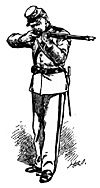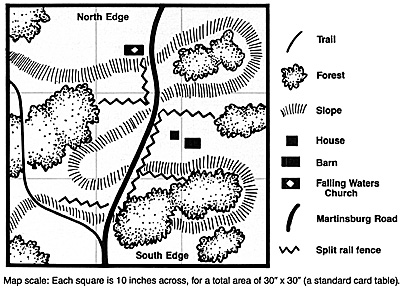 Occasionally, a skirmish occurs that is
significant only for who was there, or for
what didn't happen. Such a battle was Falling
Waters because it represented the first
combat for some of the Civil War's most
famous commanders.
Occasionally, a skirmish occurs that is
significant only for who was there, or for
what didn't happen. Such a battle was Falling
Waters because it represented the first
combat for some of the Civil War's most
famous commanders.
On the Confederate side you had Colonel J.E.B. Stuart, Colonel Thomas Jackson ... soon to be "Stonewall" ... and the preacher artillerist, Captain Sandie Pendleton.
For the Union, you had the soon-to- be-forgotten General George Cadwallader, but you also had a new colonel who would become a big thorn in the Confederate side ... Colonel George H. Thomas (later known as the "Rock of Chickamauga").
HISTORICAL SITUATION
While the new armies were gathering for (First) Bull Run, out in the Shenandoah Valley a minor campaign was fought that would have serious strategic consequences. Union Major General Patterson was a befuddled old man operating under confused and undefined orders with the 11 generic" objective to push southward into the Shenandoah Valley. One of his thrusts was commanded by a Brigadier Cadwallader who crossed the Potomac River and headed for Martinsburg.
He really wasn't looking for a fight, but his feisty, lemon-sucking opponent was. Stretching his orders, a dour-faced Colonel Thomas Jackson and his flamboyant side- kick, J.E.B. Stuart, rushed up to give the Federals a proper Virginia welcome.
SCENARIO VICTORY CONDITIONS
The Federals win if they force the Confederates off the battle field. This is assumed to happen if the Confederates lose more than 50% of their unit "points" removed. The Secessionists win if they avoid the above or inflict 30% unit "poin&' lost on the Union side. The game has no turn limit, and continues until either side achieves its victory conditions.
HISTORICAL RESULT
The battle was started by Jackson's 5th Virginia Regiment which opened fire from the edge of the woods on the advancing Federal skirmishers of Abercrombie's Brigade. Letting their elan get the best of them, the Rebels moved forward to occupy the barn and farmhouse between the lines, but soon the fire from the two Unionist regiments caused them to think better of it and retire back to the woods. By this time the Bluecoated cavalry was up, and, mistaking the retiring Virginia soldiers for routing troops, bravely charged down the road ... and right into Pendleton's six- pounders. It took only one cannonball into the head of their column and the Federal horsemen fled from the field in confusion.
Meanwhile, J. E.B. Stuart had taken his 1st Virginia Cavalry Regiment around the Union right flank by means of a winding country trail, and pounced on a group of 50 Union stragglers who took one look at the shotgun-wielding Stuart and promptly surrendered. Rather than push on, Stuart decided to simply bring his prisoners back to the Confederate lines. On the other side of the field things were looking up for the Union.
Col. Thomas and his three regiments had arrived and began working around the Confederate right flank. Jackson quickly decided to yield the present position rather than risk being out flanked. Fortunately, Jackson's retreat coincided with the arrival of two fresh Confederate regiments and the rest of Pendleton's guns. Now Jackson had all his forces in line and ready to continue the engagement.
At this point, Cadwallader rode forward, and upon seeing the "massive" Secessionist reinforcements ordered Thomas to fall back to the original Union position and await the arrival of the rest of Pattersons division. Jackson, who had already stretched Johnston's intent of "limited reconnaissance" by provoking a battle, fell back below Martinsburg to await the rest of Johnston's army for a possible showdown with Patterson's army. Not counting the 50 Union prisoners, both sides lost about 15 casualties.
NOTE: General Johnston was so pleased with Jackson's performance at Falling Waters that he recommended his promotion. Robert E. Lee, in Richmond, immediately concurred and effective the next day, July 3, Thomas Jackson was a Brigadier General.
TROOP QUALITY
This was the first combat for the troops of both sides, but Jackson's infantry is rated as veteran because of his stern training and drilling. Stuart's cavalry is rated elite because this nucleus of his famed cavalry corps was composed of the finest horsemen in the state of Virginia. The U.S. artillery is considered elite because of their high level of training.
SPECIAL RULES
1. Cavalry may only fight mounted as it was considered "unmanly" to grovel like a common infantryman. (This attitude changed quickly as soon as cavalrymen realized what a good target they were on a horse.)
2. At the start of the game, each infantry regiment must roll one six-sided die to see what kind of weapon it has:
FEDERAL INFANTRY
- 1,2,3 = smoothbore
muskets
4,5,6 =rifle muskets
REBEL INFANTRY
-
1,2,3,4 =smoothbore muskets
5,6 =rifle muskets
TERRAIN DESCRIPTION
 The area around Falling Waters Church
was gently undulating. The hills were low
with very mild slopes which offered "up hill"
protection but didn't hinder movement (no
extra movement cost-treat as "open" terrain).
The road was good quality and the trail was
wide enough for a column of infantry or
cavalry to use it. 'I he woods were light,
consisting of scattered oak and cedars. All
fences were the classic split-rail type, and
the weather was sunny and clear. All in all, it
was a fine little battlefield on a splendid
summer's day.
The area around Falling Waters Church
was gently undulating. The hills were low
with very mild slopes which offered "up hill"
protection but didn't hinder movement (no
extra movement cost-treat as "open" terrain).
The road was good quality and the trail was
wide enough for a column of infantry or
cavalry to use it. 'I he woods were light,
consisting of scattered oak and cedars. All
fences were the classic split-rail type, and
the weather was sunny and clear. All in all, it
was a fine little battlefield on a splendid
summer's day.
UNION STARTING FORCES
Overall Commander: Brigadier General George Cadwallader, Points: 5, Benefit: 0 (enters with 1st Brigade)
1st BRIGADE
Col. J.J. Abercrombie, Points: 3, Benefit: 1
(Enters Turn One, on north edge, in
march column along the Williamsport Road)
- 1st Sqd, Pbiladelpbia City Troop
Cavalry: 10 mounted figures, green troops,
armed with carbines
1st Wisconsin, 25 figures, green troops
11th Pennsylvania, 25 figures, green troops
1st Section, Battery F 4th US. Artillery two 10# parrot rifles, elite crew
UNION REINFORCEMENTS: TURN THREE
- (Enter on road as did 1st Brigade)
2nd BRIGADE
Col. George H. Thomas, Points: 3, Benefit: 1
6th Pennsylvania, 25 figures,
green troops
21st Pennsylvania, 25 figures,
green troops
23rd Pennsylvania 25 figures,
green troops
2nd Section, Battery F 4th US.
Artillery two 10# parrot rifles, elite
crew
UNION UNIT "POINTS"
- One divisional officer (Cadwallader) =
5
Two brigade officers @ 3/per = 6
Five regiments @ 2/per = 10
One cavalry troop = 5
Two gun sections @ 1 /per = 2
Total unit points = 28
Thirty percent of these points removed (total 8) means that Union troops may no longer advance towards the Rebels.
CONFEDERATE STARTING FORCES
On board at start and may deploy anywhere within 1' of south edge of map.
Col. Thomas Jackson: Pts 5, Benefits
2
5th VA 20 figures, vets
1st Section, Rockbridge Artilley, 6#
smoothbores, vets
1st Troop, 1st VA Cav: 10 mtd
figures, armed with shotguns, elite
Col. JEB Stuart, Pts: 3 benefits: 1
with any other unit, 2 with 1st VA
CONFEDERATE
REINFORCEMENTS:
TURN FOUR
(Enter on Williamsport Road march column,
south edge)
2nd VA, 25 figures, vets
TURN 6
(Enter on Williamsport Road march column,
south edge)
4th VA, 25 figs, vets
2nd section, Rockbridge Artillery, 6#
smoothbores, vets
CONFEDERATE UNIT
"POINTS"
Jackson = 5
Stuart = 3
Three regiments @ 2/per = 6
One cavalry troop = 3
Two gun sections @ 1 /per = 2
Total unit points = 19
Fifty percent of these points removed (total 9) means that Rebel troops must withdraw.
This scenario was designed specifically for use with 10mm or 15mm miniatures and the Johnny Reb American Civil War war game rules published by Adventure Games Inc. It can, however be used with any ACW rules system that uses regiments as the primary maneuver element, regardless of the number of figures per regiment or per stand.
Back to Table of Contents -- Game News #2
To Game News List of Issues
To MagWeb Master Magazine List
© Copyright 1999 by Dana Lombardy.
This article appears in MagWeb (Magazine Web) on the Internet World Wide Web.
Other military history articles and gaming articles are available at http://www.magweb.com